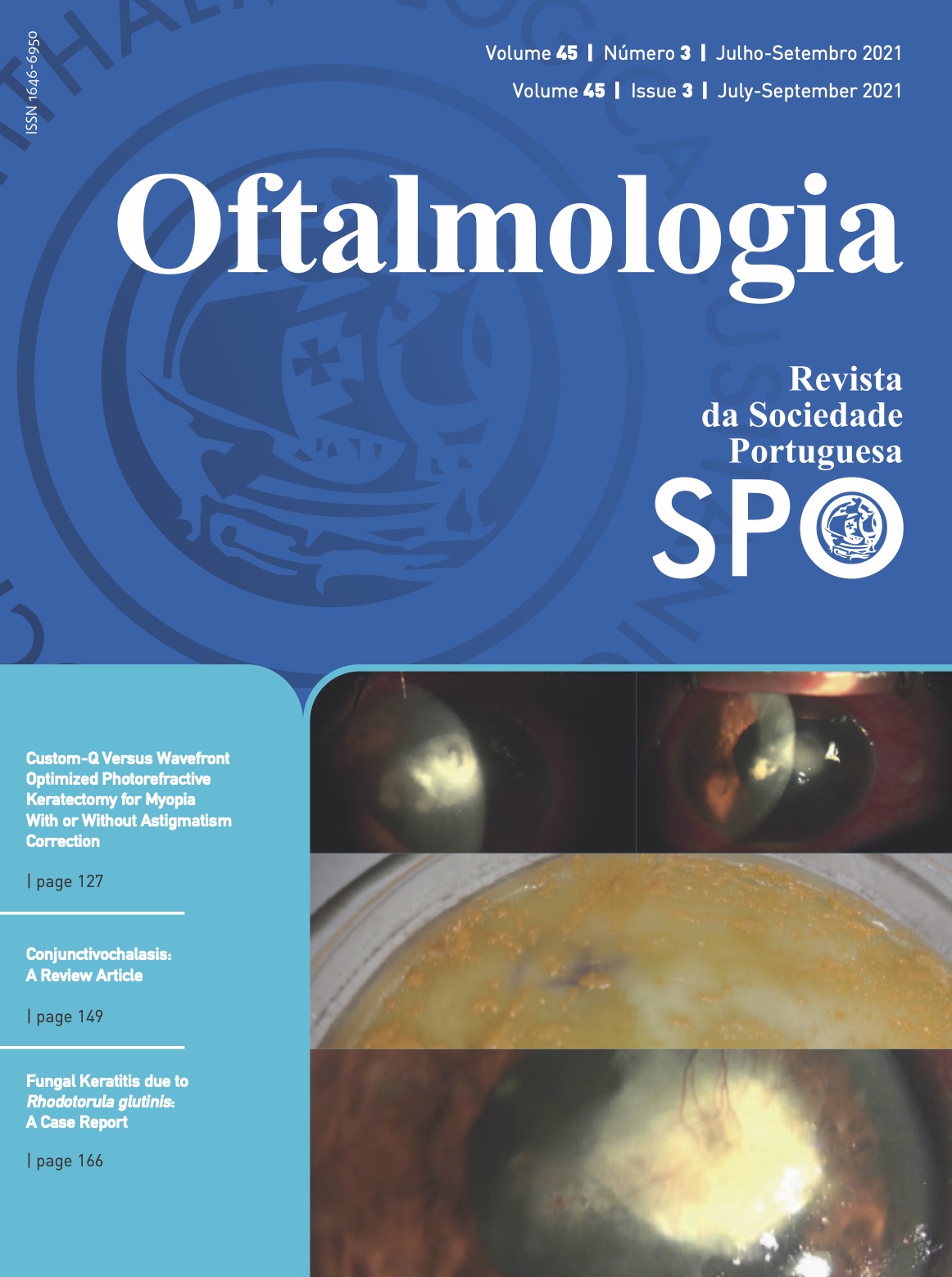Fungal keratitis due to Rhodotorula glutinis: A Case Report
DOI:
https://doi.org/10.48560/rspo.24659Keywords:
Antifungal Agents, Corneal Ulcer, Eye Infections, Fungal, Keratitis, RhodotorulaAbstract
We describe a case of mycotic keratitis involving a rare fungus and review the literature on Rhodotorula keratitis. A 40-year-old man was struck in the right eye with a tree branch and developed a corneal ulcer involving the anterior portion of the cornea. Cultures grew Rhodotorula glutinis. The patient was initially treated with topical amphotericin, but only improved with topical and intracameral voriconazole administration. The corneal infiltrate resolved, leaving an anterior stromal scar, and the patient’s best-corrected visual acuity was 20/60 in the involved eye.
Cases of Rhodotorula keratitis can pose a challenge to the ophthalmologist, with the diagnosis and the treatment regimen, as this yeast may not respond well to commercially available drugs. We report a case of Rhodotorula keratitis that was only resolved with voriconazole. Our case rein- forces the importance of the early diagnosis and correct management of fungal keratitis involving this rare, but potentially damaging yeast.
Downloads
References
Thomas PA, Kaliamurthy J. Mycotic keratitis: epidemiology, diagnosis and management. Clin Microbiol Infect. 2013;19:210-20. doi: 10.1111/1469-0691.12126.
Mascaro VL, Hofling-Lima AL, Gompertz O, YU MC, Matta DA, Colombo A. Antifungal susceptibility testing of yeast isolated from corneal infections. Arq Bras Oftalmol. 2003;66:647- 52. doi:10.1590/S0004-27492003000500019.
Ong HS, Fung SSM, Macleod D, Dart JKG, Tuft SJ, Burton MJ. Al- tered patterns of fungal keratitis at a London ophthalmic referral hospital: an eight-year retrospective observational study. Am J Ophthalmol. 2016;168:227-236. doi: 10.1016/j.ajo.2016.05.021.
Wirth F, Goldani LZ. Epidemiology of Rhodotorula: an emerging pathogen. Interdiscip Perspect Infect Dis. 2012;2012:465717. doi: 10.1155/2012/465717.
Gomez-Lopez A, Mellado E, Rodriguez-Tudela JL, Cuenca- Estrella M. Susceptibility profile of 29 clinical isolates of Rhodotorula spp. and literature review. J Antimicrob Chemother. 2005;55:312-6. doi: 10.1093/jac/dki020.
Tuon FF, Costa SF. Rhodotorula infection. A systematic review of 128 cases from literature. Rev Iberoam Micol. 2008;25:135- 40. doi: 10.1016/s1130-1406(08)70032-9.
Francois J, Rijsselaere M. Corneal infections by Rhodotorula. Ophthalmologica. 1979;178:241-9.
Giovannini J, Lee R, Zhang SX, Jun AS, Bower KS. Rhodotorula keratitis: a rarely encountered ocular pathogen. Case Rep Ophthalmol. 2014;5:302-10. doi: 10.1159/000365986.
Muralidhar S, Sulthana CM. Rhodotorula causing chronic dacryocystitis: a case report. Indian J Ophthalmol. 1995;43:196-198.
Panda A, Pushker N, Nainiwal S, Satpathy G, Nayak N. Rhodotorula sp. infection in corneal interface following lamellar keratoplasty--a case report. Acta Ophthalmol Scand. 1999;77:227-8. doi: 10.1034/j.1600-0420.1999.770223.x.
Pradhan ZS, Jacob P. Management of Rhodotorula scleritis. Eye. 2012;26:1587. doi: 10.1038/eye.2012.181.
Dorey MW, Brownstein S, Kertes PJ, Gilberg SM, Toye B. Rhodotorula glutinis endophthalmitis. Can J Ophthalmol. 2002;37:416-8. doi: 10.1016/s0008-4182(02)80045-x.
Marujo FI, Hirai FE, YU MC, Hofling-Lima AL, Freitas D, Sato E. Distribution of infectious keratitis in a tertiary hospital in Brazil. Arq Bras Oftalmol. 2013;76:370-3. doi:10.1590/S0004-27492013000600011.
Muniz de Andrade AJ, Vieira LA, Höfling-Lima AL, Yu MC, Gompertz OF, Freitas D, et al. Laboratorial analyses of fungal keratitis in a University Service. Arq Bras Oftalmol. 2000;63:59-63. doi: 10.1590/S0004-27492000000100012
He D, Hao J, Zhang B, Yang Y, Song W, Zhang Y, Yokoyama K, Wang L. Pathogenic spectrum of fungal keratitis and specific identification of Fusarium solani. Invest Ophthalmol Vis Sci. 2011;52:2804-8. doi: 10.1167/iovs.10-5977.
Chowdhary A, Singh K. Spectrum of fungal keratitis in North India. Cornea. 2005;24:8-15. doi: 10.1097/01. ico.0000126435.25751.20.
Xie L, Zhong W, Shi W, Sun S. Spectrum of fungal keratitis in north China. Ophthalmology. 2006113:1943-8. doi: 10.1016/j. ophtha.2006.05.035.
Satpathy G, Ahmed NH, Nayak N, Tandon R, Sharma N, Agar- wal T et al. Spectrum of mycotic keratitis in north India: sixteen years study from a tertiary care ophthalmic centre. J Infect Pub- lic Health. 2019;12:367-71. doi: 10.1016/j.jiph.2018.12.005.
Arendrup MC, Boekhout T, Akova M, Meis JF, Cornely OA, Lortholary O. ESCMID and ECMM joint clinical guidelines for the diagnosis and management of rare invasive yeast infections. Clin Microbiol Infect. 2014;20:76-98. doi: 10.1111/1469-0691.12360.
Saha S, Sengupta J, Chatterjee D, Banerjee D. Rhodotorula mucilaginosa keratitis: A rare fungus from Eastern India. In- dian J Ophthalmol. 2014;62:341-4.
Downloads
Published
How to Cite
Issue
Section
License
Copyright (c) 2021 Revista Sociedade Portuguesa de Oftalmologia

This work is licensed under a Creative Commons Attribution-NonCommercial 4.0 International License.
Do not forget to download the Authorship responsibility statement/Authorization for Publication and Conflict of Interest.
The article can only be submitted with these two documents.
To obtain the Authorship responsibility statement/Authorization for Publication file, click here.
To obtain the Conflict of Interest file (ICMJE template), click here





